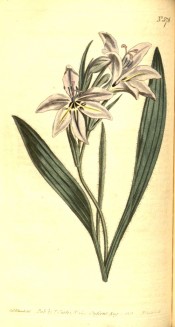Babiana disticha Ker-Gawl.
Leaves lance-shaped, hairy, flowers pale yellow or shades of blue marked with yellow, fragrant. To 20cm. [RHSD, Hortus, CECB].
Horticultural & Botanical History
‘Cultivated, according to the Banksian Herbariam, at Kew Gardens in 1778.’ [BM t.576/1802]. ‘Is easily increased, but like the whole of this genus is not so free to blow as Ixia, Watsonia or Gladiolus; we think it advisable not to remove the roots from their pots above once in three or four years, as these require to be of a good age before they flower at all, and are not nearly so liable to rot as many of the species of Ixia and Gladiolus.’ [BM t.626/1803]. Ker Gawler regarded the two plants he described as separate species although they seem to vary only in flower colour.
History at Camden Park
Received per ‘Sovereign’ February 1831 as Gladiolus plicatus. [MP A2948-2]. Both Babiana disticha and B. plicata are marked with a ‘c’ in a copy of Loddiges’ 1836 catalogue meaning ‘grown at Camden’. Babiana stricta caerulea is also marked, but the ‘c’ is crossed with a single dash. The meaning is unknown but as it doesn’t appear in the 1843 catalogue it was probably lost. [CPA].
Notes
Published Oct 18, 2009 - 02:21 PM | Last updated Jul 23, 2010 - 11:43 AM
| Family | Iridaceae |
|---|---|
| Category | |
| Region of origin | South Africa, Cape district |
| Synonyms |
|
| Common Name | Baboon root, Baboon flower |
| Name in the Camden Park Record | Gladiolus plicatus |
| Confidence level | medium |
